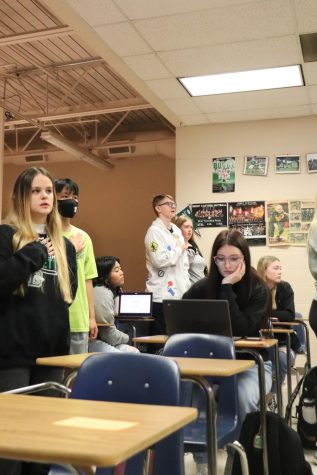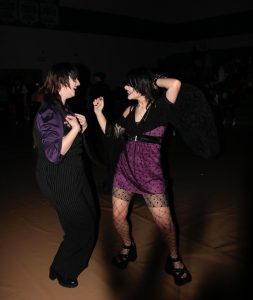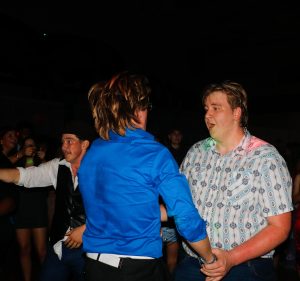Students sit or stand for the pledge (Issue 4, pg. 2)
October 28, 2021
 A sixth grade student in Florida was arrested in 2019 for not standing during the Pledge of Allegiance. He was removed from class, suspended for three days and taken to the juvenile detentioncenter with charges of disrupting a school function and resisting arrest without violence.
A sixth grade student in Florida was arrested in 2019 for not standing during the Pledge of Allegiance. He was removed from class, suspended for three days and taken to the juvenile detentioncenter with charges of disrupting a school function and resisting arrest without violence.
The case was dismissed and a civil rights complaint is pending within the US Department of Education.
Although that incident was two years ago, public opinion on whether to stand or sit during the pledge remains mixed.
“It’s a practice of your freedoms — it’s your choice to sit or stand,” senior Collin Pankey said.
In 1943, the U.S. Supreme Court ruled that forcing public school students to recite the Pledge of Allegiance is a violation of their First Amendment rights.
Every morning, principal Tim Hamblin invites the students to partake in the Pledge of Allegiance. Hamblin makes it clear that it’s a choice.
Senior Clayton Knoblock disagrees.
“I stand for the flag,” he said. “You know, you just do it. (When people sit,) they don’t care about America or the troops.”
The argument over whether to sit or stand often leads to a discussion about Colin Kaepernick, a former San Francisco 49ers quarterback who opted to kneel during the National Anthem in the final 2016 preseason game on Sept. 1, 2016.
“He did it as a protest for the injustice of African-American people at the time,” Pankey said. “He kneeled because the flag didn’t represent him.”
Similarly, Derby basketball players kneeled during the National Anthem on Jan. 5 at Maize South.
Junior Kaeson Fisher-Brown was one of the basketball players who kneeled. But at 8:01 a.m. every day, he stands for the pledge.
“I stand, but I do not look up to the flag or hold my hand above my heart,” Fisher- Brown said. “Last year, even after we kneeled, I talked to a previous or former soldier and we had a conversation about it.
“The standing part is a sign of respect but the other part is about what we were making a stand for in the first place.”
Colonel Michael Dillard, who teaches AFJROTC, served 30 years in the Air Force as an aircraft maintenance and logistics officer.
“Students have the right to either sit or stand,” Dillard said. “(When students sit), they don’t fully understand what the pledge is all about and what this country is about.
“It’s about pledging allegiance to the country where you are a citizen or that you serve and you choose to honor it by standing.”
Junior Ashyra Duke sits during the pledge.
“I just don’t believe in the idea that we are all free,” Dukes said. “We still have issues with racism and sexism and things like that. And until we have the same rights a white, Christian male would have, (we are not free).”






